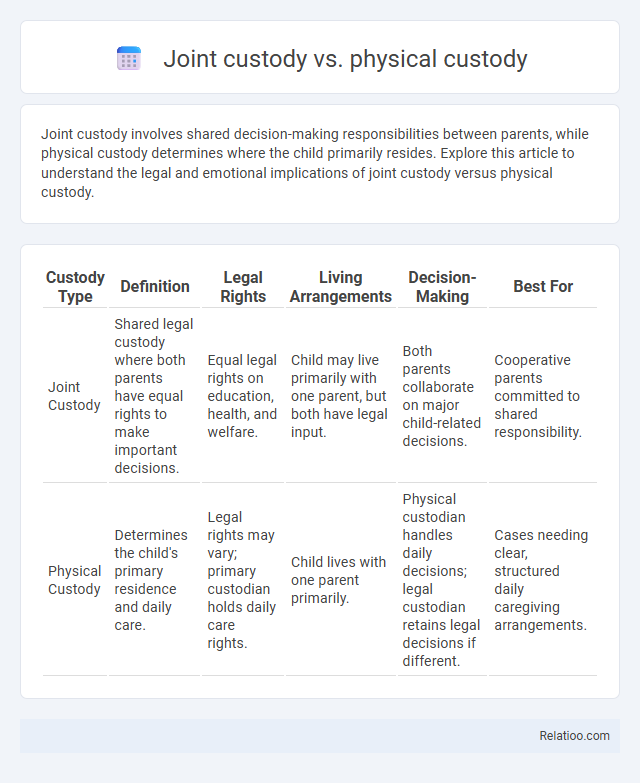Joint custody involves shared decision-making responsibilities between parents, while physical custody determines where the child primarily resides. Explore this article to understand the legal and emotional implications of joint custody versus physical custody.
Table of Comparison
| Custody Type | Definition | Legal Rights | Living Arrangements | Decision-Making | Best For |
|---|---|---|---|---|---|
| Joint Custody | Shared legal custody where both parents have equal rights to make important decisions. | Equal legal rights on education, health, and welfare. | Child may live primarily with one parent, but both have legal input. | Both parents collaborate on major child-related decisions. | Cooperative parents committed to shared responsibility. |
| Physical Custody | Determines the child's primary residence and daily care. | Legal rights may vary; primary custodian holds daily care rights. | Child lives with one parent primarily. | Physical custodian handles daily decisions; legal custodian retains legal decisions if different. | Cases needing clear, structured daily caregiving arrangements. |
Understanding Joint Custody
Joint custody refers to both parents sharing the rights and responsibilities of making major decisions about their child's welfare, education, and health. It differs from physical custody, which specifically concerns where the child lives and the day-to-day caregiving arrangements. Understanding joint custody involves recognizing its emphasis on cooperative parenting and legal authority, regardless of the child's primary residence.
What is Physical Custody?
Physical custody refers to the legal determination of where a child lives and the parent responsible for their daily care and supervision. It differs from joint custody, which involves sharing decision-making responsibilities, and can be awarded solely or jointly, depending on what best serves the child's interests. Understanding physical custody helps you navigate custody agreements and establish clear parenting time arrangements.
Key Differences Between Joint and Physical Custody
Joint custody involves both parents sharing legal and/or physical custody, ensuring decision-making power and child-rearing responsibilities are divided. Physical custody refers to where the child lives most of the time, highlighting the parent with whom the child primarily resides. The key difference lies in joint custody emphasizing shared legal rights and responsibilities, while physical custody centers on the actual living arrangements.
Legal Implications of Each Custody Type
Joint custody typically involves shared legal decision-making responsibilities between parents, ensuring both have equal rights in important aspects like education, healthcare, and religious upbringing. Physical custody determines where the child primarily resides and affects daily routines, with legal implications for visitation rights and child support obligations. Your choice between joint legal custody, physical custody, or a combination directly impacts the legal authority each parent holds and the enforcement of parenting plans in family court.
How Courts Determine Custody Arrangements
Courts determine custody arrangements by evaluating the best interests of the child, considering factors such as the child's age, health, emotional ties with parents, and each parent's ability to provide care. Joint custody typically involves shared decision-making responsibilities, while physical custody focuses on where the child will primarily live, and courts may combine these forms based on your family's unique circumstances. The goal is to create a stable environment that supports the child's wellbeing and maintains strong parental relationships.
Pros and Cons of Joint Custody
Joint custody involves both parents sharing legal decision-making responsibilities, promoting cooperative parenting and balanced involvement in the child's life, which can enhance emotional stability and continuity. Pros include equal parental input and reduced conflict through communication, while cons may involve challenges in coordinating schedules, potential disagreements in child-rearing approaches, and possible stress for the child if parents are in high conflict. Physical custody determines where the child lives most of the time, affecting daily routines, with joint physical custody offering time sharing but requiring effective cooperation, whereas sole physical custody simplifies logistics but limits one parent's access.
Pros and Cons of Physical Custody
Physical custody refers to the child living primarily with one parent, providing stability and consistent daily care, which can benefit the child's routine and emotional security. However, physical custody may limit the non-custodial parent's time and involvement, potentially causing feelings of separation or reduced bonding opportunities. Joint custody, both physical and legal, promotes shared parenting responsibilities and decision-making, fostering a balanced relationship between the child and both parents.
Impact on Children: Joint vs Physical Custody
Joint custody allows children to maintain strong relationships with both parents by sharing decision-making responsibilities, fostering emotional stability and balanced involvement. Physical custody focuses on where the child primarily resides, which can affect their daily routine and sense of security, making consistency crucial for their well-being. Your child's adjustment and emotional health often benefit more from cooperative joint custody arrangements than from sole physical custody setups.
Tips for Co-Parenting Across Custody Arrangements
Navigating joint custody, physical custody, and sole custody requires clear communication and a focus on the child's best interests to ensure stability. Establishing consistent routines, respectful communication, and flexibility in scheduling helps you manage your co-parenting responsibilities effectively across different custody arrangements. Prioritizing your child's emotional and physical needs enhances cooperation and reduces conflicts in shared parenting scenarios.
Frequently Asked Questions on Custody Decisions
Joint custody involves both parents sharing legal decision-making responsibilities regarding the child's upbringing, while physical custody refers to where the child primarily resides. Joint physical custody means the child spends significant time living with each parent, promoting involvement from both adults in daily life. Understanding these terms helps you navigate common custody questions about parenting time, legal rights, and child welfare in custody decisions.

Infographic: Joint custody vs Physical custody
 relatioo.com
relatioo.com